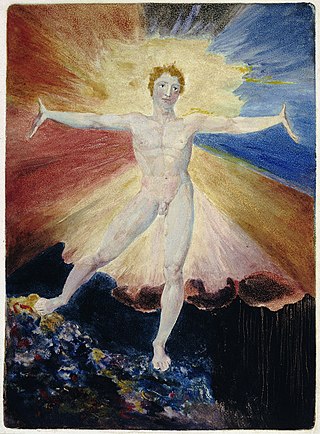 |
Victoria & Albert Museum
Pencil Drawing
ca. 1780 |
 |
| British Museum Large Book of Designs Albion Rose Color Engraving, 1794-96 |
 |
| Legend: Albion rose from where he labourd at the Mill with Slaves National Gallery The Dance of Albion Engraving c. 1803/1810 |
Artist as he was, Blake pictured Albion in his vitality. He invented his image as an engraving in 1780 revised it after 1803. He color printed it between 1794 and 1796.
The Tate Gallery book William Blake on page 242 includes this statement:
"The emergence of this image of British liberty as a giant form was the outcome of Blake's desire to create an Albion for his own times but also rooted in ancient mythology."
Annotations to Berkley's Siris, (E 663)
"Harmony [&] Proportion are Qualities & Not Things The
Harmony & Proportion of a Horse are not the same with those of a
Bull Every Thing has its
own Harmony & Proportion Two Inferior Qualities in it For its
Reality is Its Imaginative Form"
Four Zoas, Night VII, Page 98 [90], (E 370)
"Los drew them forth out of the deeps planting his right foot firm
Upon the Iron crag of Urizen thence springing up aloft
Into the heavens of Enitharmon in a mighty circle
And first he drew a line upon the walls of shining heaven
And Enitharmon tincturd it with beams of blushing love
It remaind permanent a lovely form inspird divinely human
Dividing into just proportions Los unwearied labourd
The immortal lines upon the heavens till with sighs of love
Sweet Enitharmon mild Entrancd breathd forth upon the wind
The spectrous dead Weeping the Spectres viewd the immortal works
Of Los Assimilating to those forms Embodied & Lovely
In youth & beauty in the arms of Enitharmon mild reposing"
Inscriptions, WB inv 1780, (E 671)
"Albion rose from where he labourd at the Mill with Slaves
Giving himself for the Nations he danc'd the dance of Eternal Death"
Four Zoas, Night IX, Page 134, (E 402)
"Let the slave grinding at the mill run out into the field
Let him look up into the heavens & laugh in the bright air
Let the inchaind soul shut up in darkness & in sighing
Whose face has never seen a smile in thirty weary years
Rise & look out his chains are loose his dungeon doors are open"
Leonardo da Vinci's Vitruvian Man:
More More.

No comments:
Post a Comment